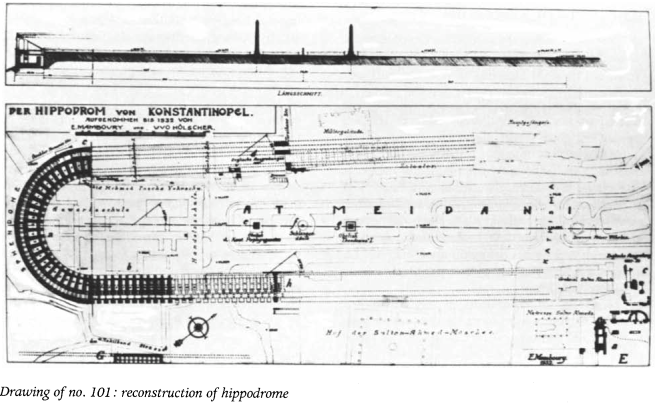Hippodrome. Constantinople (Istanbul), 3rd-4th century. Plan
The hippodrome of Constantinople served as a focal point of urban life. There, the populace congregated, principally to enjoy chariot races and its idols, the charioteers. The hippodrome also served as a substitute forum, where the populace could communicate with the emperor and vent its feelings on political and social issues. In the hippodrome, emperors and generals victorious in battle were greeted; executions and punishments of criminals—occasionally even of emperors—were witnessed; and announcements of imperial births were made. When Constantine dedicated his new capital in 330, most of the forty- day celebration unfolded in the hippodrome, and it was there that the Nika riot, which almost led to the overthrow of Justinian I in 532, erupted, leaving at least 30,000 dead.

Little of the hippodrome survives. First laid out under Septimius Severus at the beginning of the third century, the hippodrome was based on the Circus Maximus in Rome, the model for most monumental Roman racecourses. It was enlarged by Constantine. In layout and appointments it was also much like the Circus of Maxentius in Rome (cf. no. 100). Unlike its Roman prototypes, however, that of the Constantinopolitan hippodrome falls away sharply to the southwest. This necessitated the U-shaped end (the sphendone) to be erected on massive substructures. This Severan portion of the hippodrome still towers above the slope and forms the limit of the upper terrace of the Turkish Palace of Justice built in the 1950s.
The kathisma was located in the middle of the southeast side of the hippodrome immediately above the stama. The emperor and his retinue- entered it from a spiral staircase, known as the cochlias, that communicated directly with the palace. The palace and hippodrome in Late Antique capital cities were often adjacent (see no. 107).
The exact height of the tiers of seats in the hippodrome has not been determined, but there were probably between thirty and forty tiers that could have accommodated as many as 60,000 spectators. Originally constructed of wood, they were later replaced with marble. The spectators rented cushions, rugs, benches, or chairs from attendants; the demarchs sat in armchairs.
As at Rome, the carceres and storage areas were situated at the northeast end. Bibliography: Casson et al„ 1928; Casson et al., 1929; MacDonald, 1956; Guilland, 1969, I, pp. 369-555; Guilland, 1970.
Date added: 2025-08-01; views: 210;
